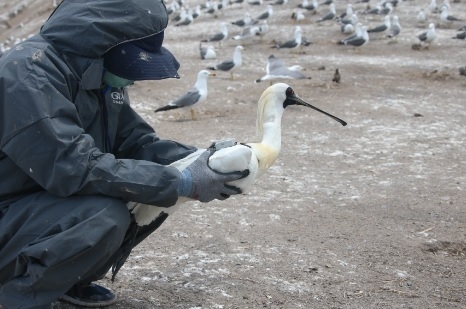
The Cultural Heritage Administration's National Research Institute of Cultural Heritage (Kim Yeonsoo, General Director) attached location trackers to the adult and juvenile of a Natural Monument the Black-faced spoonbill that successfully breed in Chilsando islet, Yeonggwang last year, and confirmed the migration route of the three families for the first time.
In the past, the Black-faced spoonbill migration route studies have been conducted on breeding juvenile individuals, but this is the first time that it has been conducted in a family unit to compare migration routes between parents and offspring. As a result of analyzing the paths of three families (8 individuals), it was feeding in the tidal flat of the southwest coast and confirmed that adult and juvenile migrated to China and Taiwan by different for overwintering. In the case of male individuals (nhc2202, nhc2205, nhc2208) among the adult, they flew about 1,624km at an average speed of 50km per hour and finally arrived in Taiwan. In the case of the juvenile (nhc2204, nhc2206, nhc2207, nhc2210), they flew about 967km at an average speed of 47km per hour and arrived in China, and the other one (nhc2203) flew about 1,379km at an average speed of 51km per hour and arrived in Taiwan.
Through this, it was found that juvenile individuals do not education or learn a specific route of movement from adults, but rather learn a route specialized for long-distance travel.
Research information on the migration route of Black-faced spoonbills can be found at the ‘Natural Monument Ecological Map Service (http://gis-heritage.go.kr)’, the website of the Cultural Heritage Administration (www.cha.go.kr) linked with the cultural heritage GIS system.
The Black-faced Spoonbill is a species that desperately needs protection as there are only 3,940 surviving in the world. Accordingly, the National Research Institute of Cultural Heritage plans to carry out restoration of breeding grounds to conserve the Black-faced Spoonbill and breeding grounds together. In addition to Chilsando islet breeding sites, we will organize an on-site investigation team to establish efficient management plans for wintering sites in China and Taiwan, where the Black-faced Spoonbill during the winter season, in cooperation with related organizations.
(한국어 번역)
한국다문화뉴스 = 심민정 기자ㅣ문화재청 국립문화재연구원(원장 김연수)은 지난해 영광 칠산도에서 번식에 성공한 천연기념물 저어새 세 가족의 부모개체(수컷 3마리)와 자식개체(수컷 5마리)에 각각 위치추적기를 부착한 끝에 겨울나기 이동경로를 최초로 확인하였다.
그간 저어새 이동경로 연구는 번식한 유조(어린개체)를 대상으로 수행하였으나, 이번에는 부모개체와 자식개체의 이동경로를 비교하기 위해 처음으로 가족 단위의 연구를 진행하였다. 그동안 여름철새인 저어새 성조(부모개체)가 중국과 대만 등에서 겨울을 나는 것은 널리 알려진 사실이었으나 정확한 이동경로는 밝혀지지 않았다.
이에 국립문화재연구원은 지난해 6월 저어새 세 가족에 위치추적기를 부착하고 방사한 후 지난해 10월 초부터 11월 초 사이에 겨울나기를 위해 이동하는 각 개체들의 경로를 분석한 결과, 서남해안 연안 갯벌에서 먹이를 먹고, 겨울을 나기 위해 부모와 자식개체가 서로 다른 경로로 중국과 대만으로 이동하는 것으로 확인되었다.
부모 중 수컷개체(nhc2202, nhc2205, nhc2208)의 경우 평균 시속 50km의 속력으로 약 1,624km를 비행하여 대만에 최종 도착했으며, 자식개체 5마리 중 4마리(nhc2204, nhc2206, nhc2207, nhc2210)는 평균 시속 47km의 속력으로 약 967km를 비행하여 중국에 도착한 반면, 다른 1마리(nhc2203)는 평균 시속 51km의 속력으로 약 1,379km를 비행하여 대만에 도착한 것으로 나타났다.
이를 통해 자식개체가 부모개체로부터 특정 이동경로를 교육받거나 학습하는 것이 아닌, 겨울나기를 위한 장거리 이동에 특화된 이동경로를 스스로 학습한다는 사실을 알 수 있었다.
이번 저어새 이동경로에 대한 연구정보는 문화재청 누리집(www.cha.go.kr)에서 문화재 공간정보(GIS)시스템과 연계한 ‘천연기념물 생태지도 서비스(http://gis-heritage.go.kr)’에서 확인할 수 있다.
저어새는 전 세계에 3,940여 마리만 생존하고 있어 보호가 절실한 종이다. 이에 국립문화재연구원은 저어새와 번식지를 함께 보존하기 위한 번식지 복원을 수행해 나갈 계획이며, 칠산도 번식지뿐만 아니라 저어새가 겨울을 나는 중국이나 대만 월동지에 대해서도 현지조사단을 구성하여 효율적인 관리방안 수립을 위한 실태조사에 나설 계획이다.





















